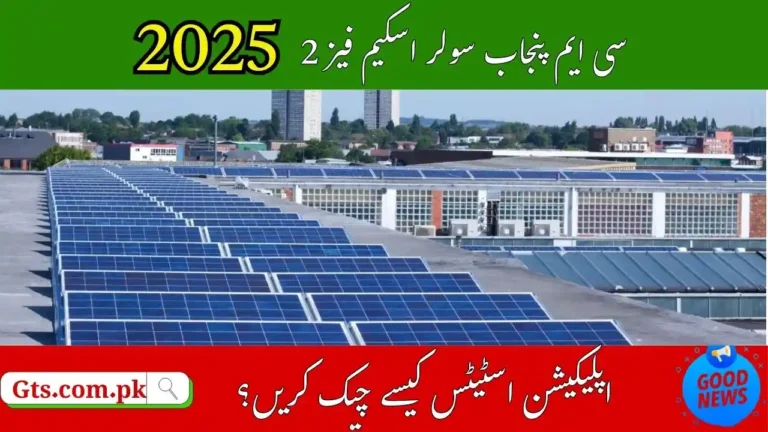Punjab Solar Scheme 2025 Environmental Impact – Greener Future Through Phase 2
The Punjab Solar Scheme 2025 Environmental Impact has become a subject of great importance as the government prepares to roll out Phase 2 of this landmark initiative. With rising energy demands, increasing electricity costs, and growing concerns about climate change, renewable energy has emerged as the most viable path forward. Punjab’s solar scheme not only provides affordable energy but also reduces the province’s dependence on fossil fuels, thereby creating a greener and more sustainable future.
Read Also: Punjab Solar Scheme Phase 2 Eligibility 2025
Understanding the Punjab Solar Scheme 2025?
The Punjab Solar Scheme was launched to promote renewable energy adoption by making solar technology affordable and accessible. The program provides subsidized rooftop solar systems for households and businesses, reducing reliance on traditional power sources.
- Phase 1 Achievements: Thousands of homes benefited, though delays in approvals and equipment shortages slowed progress.
- Phase 2 Goals: Broader coverage, better infrastructure, and a stronger focus on environmental sustainability.
- Long-term Vision: Achieve energy independence and cut carbon emissions while supporting low-income families with subsidies.
Read Also: Punjab Solar Panel Scheme 2025
Punjab Solar Scheme 2025 Environmental Impact in Phase 2?
Reduction in Carbon Emissions?
One of the most direct environmental benefits of Phase 2 is a significant reduction in carbon emissions. By replacing fossil-fuel-generated electricity with solar power, Punjab can lower its overall carbon footprint and contribute to global climate goals.
Cleaner Air and Public Health Benefits?
Burning fossil fuels releases harmful pollutants such as sulfur dioxide, nitrogen oxides, and particulate matter. Solar energy production is clean, reducing air pollution levels in cities and improving public health. This is particularly crucial in urban areas of Punjab where smog and respiratory illnesses are common.
Sustainable Energy for Rural Areas?
Rural communities in Punjab often face inconsistent power supply. Phase 2 installations will extend renewable energy access to these regions, ensuring cleaner and uninterrupted electricity, which also reduces reliance on diesel generators that harm the environment.
Preservation of Natural Resources?
Traditional electricity generation requires large amounts of coal, oil, and gas. Solar energy, by contrast, depends only on sunlight—an abundant and renewable source. By scaling up solar adoption, Punjab reduces its exploitation of non-renewable resources, safeguarding them for future generations.
Contribution to Global Climate Commitments?
Pakistan is a signatory to multiple international climate agreements. Punjab’s solar expansion through Phase 2 strengthens the country’s commitment to renewable energy adoption and positions the province as a leader in climate responsibility.
Government’s Role in Strengthening Environmental Outcomes?
The Punjab government has structured Phase 2 of the solar scheme with sustainability as a core priority. Key strategies include:
- Target of 200,000 Installations: More clean energy production, reducing pressure on the grid.
- Green Policy Alignment: Integration of renewable energy policies with broader climate action strategies.
- Training Programs: Preparing skilled technicians to ensure efficient installations with minimal environmental disruption.
- Public Awareness Campaigns: Educating citizens about the long-term environmental benefits of adopting solar energy.
Challenges to Achieving Environmental Goals?
While the environmental benefits are significant, challenges remain:
- Supply Chain Disruptions: Shortages in solar panels or batteries could delay installations.
- Improper Waste Management: End-of-life solar equipment could pose recycling challenges if not handled properly.
- Land Use Concerns: Large-scale installations may require land that could otherwise support agriculture.
- Public Adoption Rates: If citizens are slow to adopt, the scheme may fall short of its environmental impact targets.
Opportunities for a Greener Punjab?
Despite challenges, Phase 2 creates powerful opportunities:
- Lower Household Bills + Cleaner Energy: Families save money while supporting environmental goals.
- Business Growth in Green Sector: Encourages eco-friendly enterprises and green jobs.
- Educational Impact: Schools and institutions adopting solar can spread awareness about sustainability.
- Energy Independence: Reduced reliance on imported fossil fuels strengthens Punjab’s economy and environmental security.
Citizens’ Role in Enhancing Environmental Impact?
For the Punjab Solar Scheme 2025 to succeed environmentally, citizens must actively participate:
- Apply early and prepare documents to avoid delays.
- Maintain solar equipment to ensure long-term efficiency.
- Support recycling programs for future solar waste management.
- Spread awareness in communities about the environmental benefits of renewable energy.
Read Also: CM Punjab Solar Scheme Phase 2 FAQs – Most Asked Questions (2025)
FAQs – Punjab Solar Scheme 2025 Environmental Impact?
1. What is the main environmental benefit of the Punjab Solar Scheme 2025?
The scheme reduces carbon emissions by replacing fossil-fuel-generated electricity with clean solar energy.
2. How does Phase 2 of the scheme support rural communities?
It provides reliable solar installations in rural areas, reducing reliance on diesel generators and ensuring uninterrupted clean energy.
3. Will solar energy improve air quality in Punjab?
Yes. By lowering reliance on fossil fuels, the scheme reduces pollutants such as sulfur dioxide and nitrogen oxides, leading to better air quality.
4. How many households will benefit in Phase 2?
Over 200,000 households are expected to receive installations during this phase.
5. Are there environmental challenges with solar adoption?
Yes. Challenges include recycling end-of-life solar panels, supply chain shortages, and potential land use conflicts.
6. How does the scheme align with global climate goals?
Punjab’s solar expansion supports Pakistan’s international climate commitments by increasing renewable energy adoption and reducing carbon footprints.
7. What role can citizens play in maximizing environmental benefits?
Citizens can maintain their solar systems properly, support recycling initiatives, and spread awareness about solar energy in their communities.
Conclusion Punjab Solar Scheme 2025 Environmental Impact?
The Punjab Solar Scheme 2025 Environmental Impact is profound, particularly through the expansion planned in Phase 2. By replacing fossil fuel reliance with clean solar power, Punjab is taking measurable steps toward reducing carbon emissions, improving air quality, and ensuring a greener, more sustainable future.
Although challenges such as supply chain issues and waste management need careful planning, the opportunities far outweigh the risks. With government support, citizen participation, and continued innovation, Phase 2 of the scheme will not only power homes and businesses but also power Punjab’s journey towards environmental sustainability.
This program demonstrates that renewable energy adoption is more than an economic or technological move—it is a commitment to the health, prosperity, and environmental future of the province.







